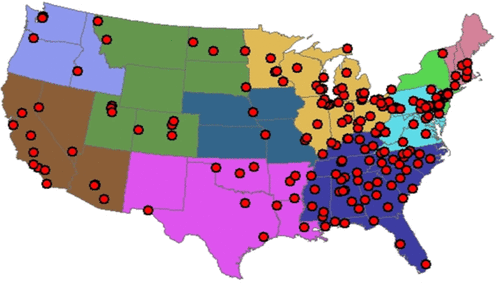当前位置:
X-MOL 学术
›
Environ. Sci. Technol.
›
论文详情
Our official English website, www.x-mol.net, welcomes your feedback! (Note: you will need to create a separate account there.)
Development of PM2.5 Source Profiles Using a Hybrid Chemical Transport-Receptor Modeling Approach
Environmental Science & Technology ( IF 11.4 ) Pub Date : 2017-11-16 00:00:00 , DOI: 10.1021/acs.est.7b03781 Cesunica Ivey 1 , Heather Holmes 2 , Guoliang Shi 3 , Sivaraman Balachandran 4 , Yongtao Hu 1 , Armistead G. Russell 1
Environmental Science & Technology ( IF 11.4 ) Pub Date : 2017-11-16 00:00:00 , DOI: 10.1021/acs.est.7b03781 Cesunica Ivey 1 , Heather Holmes 2 , Guoliang Shi 3 , Sivaraman Balachandran 4 , Yongtao Hu 1 , Armistead G. Russell 1
Affiliation

|
Laboratory-based or in situ PM2.5 source profiles may not represent the pollutant composition for the sources in a different study location due to spatially and temporally varying characteristics, such as fuel or crustal element composition, or due to differences in emissions behavior under ambient versus laboratory conditions. In this work, PM2.5 source profiles were estimated for 20 sources using a novel optimization approach that incorporates observed concentrations with source impacts from a chemical transport model (CTM) to capture local pollutant characteristics. Nonlinear optimization was used to minimize the error between source profiles, CTM source impacts, and observations. In a 2006 U.S. application, spatial and seasonal variability was seen for coal combustion, dust, fires, metals processing, and other source profiles when compared to the reference profiles, with variability in species fractions over 400% (calcium in dust) compared to mean contributions of the same species. Revised profiles improved the spatial and temporal bias in modeled concentrations of several trace metal species, including Na, Al, Ca, Mn, Cu, As, Se, Br, and Pb. In an application of the CMB-iteration model for two U.S. cities, revised profiles estimated higher biomass burning and dust impacts for summer compared with previous studies. Source profile optimization can be useful for source apportionment studies that have limited availability of source profile data for the location of interest.
中文翻译:

使用混合化学传输受体建模方法开发PM 2.5源剖面
由于空间和时间变化的特征(例如燃料或地壳元素组成),或者由于环境与环境条件下的排放行为不同,基于实验室或原位的PM 2.5污染源概况可能无法代表不同研究地点的污染源成分。实验室条件。在这项工作中,PM 2.5使用新颖的优化方法估算了20种污染源的污染源概况,该方法将观察到的浓度与化学迁移模型(CTM)的污染源相结合,以捕获当地污染物的特征。非线性优化用于最大程度地减少源剖面,CTM源影响和观测值之间的误差。在2006年的美国申请中,与参考曲线相比,煤燃烧,粉尘,火灾,金属加工和其他来源曲线具有空间和季节变化,与平均平均值相比,物种分数的变化超过400%(粉尘中的钙)同一物种的贡献。修改后的轮廓改善了几种痕量金属种类(包括Na,Al,Ca,Mn,Cu,As,Se,Br和Pb)的浓度模型中的时空偏差。在针对美国两个城市的CMB迭代模型的应用中,修订后的资料估计,与以前的研究相比,夏季更高的生物质燃烧和粉尘影响。源配置文件优化对于源分配研究非常有用,该研究对于感兴趣的位置而言,源配置文件数据的可用性有限。
更新日期:2017-11-16
中文翻译:

使用混合化学传输受体建模方法开发PM 2.5源剖面
由于空间和时间变化的特征(例如燃料或地壳元素组成),或者由于环境与环境条件下的排放行为不同,基于实验室或原位的PM 2.5污染源概况可能无法代表不同研究地点的污染源成分。实验室条件。在这项工作中,PM 2.5使用新颖的优化方法估算了20种污染源的污染源概况,该方法将观察到的浓度与化学迁移模型(CTM)的污染源相结合,以捕获当地污染物的特征。非线性优化用于最大程度地减少源剖面,CTM源影响和观测值之间的误差。在2006年的美国申请中,与参考曲线相比,煤燃烧,粉尘,火灾,金属加工和其他来源曲线具有空间和季节变化,与平均平均值相比,物种分数的变化超过400%(粉尘中的钙)同一物种的贡献。修改后的轮廓改善了几种痕量金属种类(包括Na,Al,Ca,Mn,Cu,As,Se,Br和Pb)的浓度模型中的时空偏差。在针对美国两个城市的CMB迭代模型的应用中,修订后的资料估计,与以前的研究相比,夏季更高的生物质燃烧和粉尘影响。源配置文件优化对于源分配研究非常有用,该研究对于感兴趣的位置而言,源配置文件数据的可用性有限。



























 京公网安备 11010802027423号
京公网安备 11010802027423号